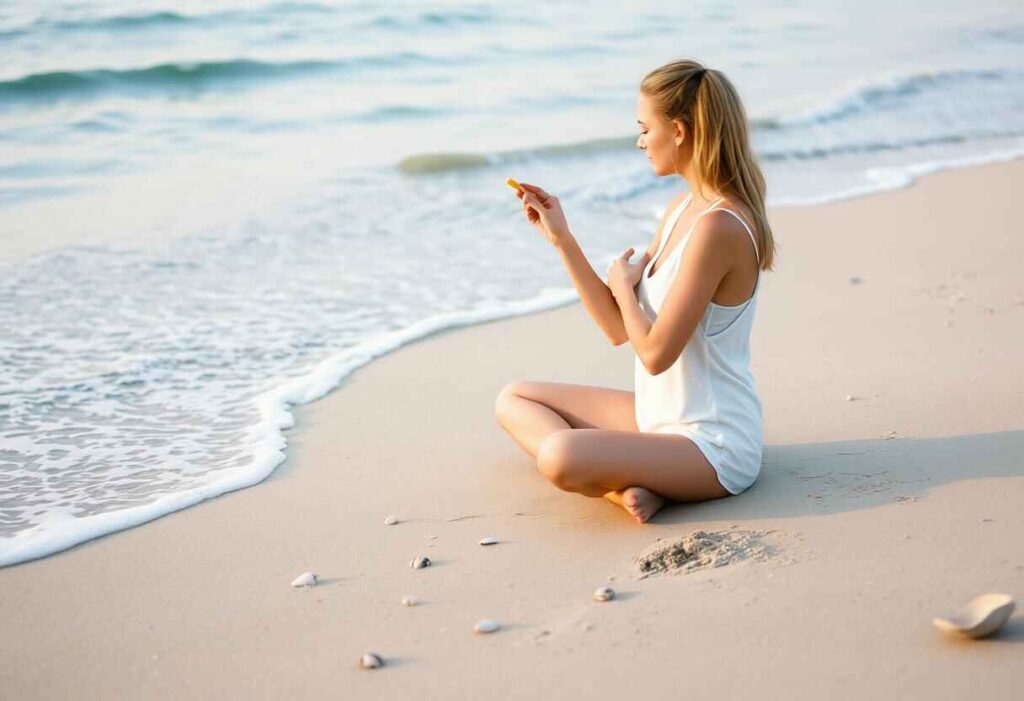Summer is here with its long, sunny days, and many people want to get a tan, which shows they’ve been enjoying the sun. But being safe in the sun is also important. So, can you still get a tan with sunscreen?
The answer is a bit tricky. It depends on what you mean by ‘tan’ and how well your sunscreen works. Sunscreen acts like a shield, blocking the sun’s harmful rays. There are two main types of these rays: UVB, which cause sunburn, and UVA, which go deeper into your skin and can cause wrinkles and aging.
Let’s talk about sunscreen
- No Sunscreen is Perfect: Even the most effective sunscreens can’t block all the sun’s rays. SPF (Sun Protection Factor) tells you how much protection you’re getting from UVB rays. SPF 30 blocks about 97% of these rays, and SPF 50 blocks about 98%. So, some UVB rays can still reach your skin, letting you tan a bit.
- Tanned Doesn’t Mean Safe: When you tan, your skin is trying to protect itself from UV damage by making more melanin, the pigment that gives skin its color. But tanning doesn’t mean you’re completely safe. You can still get sun damage even if you don’t get a sunburn, and tanning a lot increases your chances of getting skin cancer.
Keeping Your Skin Safe in the Sun
Here are some simple ways to stay safe in the sun and still get that summer glow:
- Choose the Right SPF: Use sunscreen with SPF 30 or higher every day, even if it’s cloudy. Look for ones that protect from both UVA and UVB rays.
- Put on Enough and Reapply: Don’t be shy with sunscreen. Put it on all over, including your ears, neck, lips, and feet. Every two hours, especially if you’re swimming or perspiring, reapply it.
- Stay in the Shade and Cover Up: The sun is strongest from 10 am to 4 pm, so try to do outdoor activities earlier or later. Find shade when you can. Wear things like hats, sunglasses, and long sleeves for extra protection.
- Try Safe Ways to Get a Glow: Instead of tanning in the sun, use self-tanning lotions or spray tans for a temporary tan. They’re much safer for your skin.

Can You Still Tan with Sunscreen?
Yes, you can still tan with sunscreen, but how much you tan depends on the SPF level and how much sunscreen you put on. Here’s why:
- Partial UV Protection: Sunscreen can’t block all UV rays. Even the highest SPF sunscreens let some UV rays through. These rays stimulate your skin to make melanin, which gives you a tan.
- Application Amount: You need to put on a lot of sunscreen evenly for it to work well. Most people don’t use enough, so they don’t get full protection. Also, you need to reapply sunscreen every two hours, or more often if you’re swimming or sweating. If you don’t put on enough or reapply it, you’ll still get some UV exposure and can still tan.
- Skin Type: Everyone’s skin is different. People with darker skin have more melanin, so they tan more easily even with sunscreen. People with lighter skin are more likely to burn and might tan less, even with sunscreen.
| Factor | Details | Effect on Tanning | Prevention Tips | Additional Notes |
| Sunscreen SPF (Sun Protection Factor) | Higher SPF levels provide more protection against UVB rays. SPF 30 blocks about 97% of UVB rays, while SPF 50 blocks about 98%. | Higher SPF reduces tanning, but does not eliminate it | Use SPF 30 or higher, and reapply frequently. | SPF measures UVB protection; higher numbers offer marginally more protection. |
| Type of UV Rays | – UVA Rays: Penetrate deeper into the skin, contribute to aging and tanning. | Both UVA and UVB can cause tanning. | Choose a broad-spectrum sunscreen for protection against both UVA and UVB rays. | UVA rays are constant throughout the day, while UVB intensity varies by time and location. |
| – UVB Rays: Cause sunburn and direct DNA damage. | ||||
| Application Amount and Frequency | Sunscreen should be applied generously (1 ounce for the whole body) and reapplied every 2 hours or after swimming/sweating. | Inadequate application can lead to more tanning. | Apply 15-30 minutes before sun exposure, and reapply regularly. | Under-application is common; ensure even coverage for better protection. |
| Broad-Spectrum Sunscreen | Broad-spectrum sunscreens protect against both UVA and UVB rays. | Reduces the likelihood of tanning | Ensure the sunscreen is labeled “broad-spectrum.” | Broad-spectrum sunscreens are essential for comprehensive sun protection. |
| Water Resistance | Water-resistant sunscreens maintain their SPF protection after water exposure for 40 or 80 minutes, but still need reapplication. | May help reduce tanning but still requires reapplication. | Reapply after swimming or heavy sweating. | No sunscreen is completely waterproof; reapply often. |
| Skin Type and Melanin Production | Individuals with darker skin tones produce more melanin, which can lead to easier tanning. | Darker skin tones may tan more, even with sunscreen. | Use higher SPF and broad-spectrum sunscreen regardless of skin tone. | Melanin provides some natural protection but is not sufficient against UV damage. |
| Duration and Intensity of Sun Exposure | Longer and more intense sun exposure increases the likelihood of tanning, even with sunscreen. | Prolonged exposure increases tanning. | Limit time in the sun, especially during peak UV hours (10 a.m. to 4 p.m.). | Sun intensity is higher at higher altitudes and near reflective surfaces. |
| Environmental Factors | UV intensity is affected by altitude, latitude, time of day, and reflective surfaces like water or snow. | High UV index areas increase tanning risk. | Monitor the UV index, seek shade, and wear protective clothing. | Use extra caution in high UV environments. |
| Clothing and Shade | Wearing protective clothing, hats, and seeking shade can significantly reduce UV exposure. | Minimizes tanning and sun damage. | Combine sunscreen with protective clothing and seek shade. | Clothing with a high UPF (Ultraviolet Protection Factor) is recommended. |
| Misconceptions | Some believe that a “base tan” prevents burning or that low SPF promotes safer tanning. | Any tan indicates skin damage. | Avoid the sun during peak hours and always use sunscreen. | Tanning damages the skin and increases the risk of skin cancer. |
Benefits of Sun Protection
Protecting yourself from the sun isn’t just about avoiding sunburn or getting a tan. This is why it’s essential for your well-being:
- Less Chance of Skin Cancer: Skin cancer is the most common type of cancer in the US. Being in the sun a lot raises your risk, but using sunscreen regularly can lower it.
- Keeps You Looking Young: UVA rays from the sun can make your skin age faster, causing wrinkles and sagging. Using sunscreen helps your skin stay youthful.
- Safeguards Your Eyes: Too much sun can hurt your eyes, leading to problems like cataracts and macular degeneration. Wearing sunglasses that block UVA and UVB rays is a must.

Having Fun in the Sun Safely
Putting sun protection first doesn’t have to spoil your outdoor fun. Here are some ways to have a great time while staying safe in the sun:
- Morning or Evening Fun: Schedule your hikes, picnics, or beach visits for the cooler parts of the day when the sun isn’t as strong.
- Water Play with Care: Enjoy activities like kayaking and swimming, but be sure to put on more sunscreen after you’ve been in the water.
- Find Shaded Places: Visit places like gardens, museums, or historical sites where you can enjoy some sun and some shade.
Conclusion
A beautiful summer glow starts with taking care of yourself. When you make sun protection a priority, you’re not only keeping your skin safe, but you’re also looking out for your future health. So, forget about tanning beds and focus on safe sun habits for a vibrant, healthy summer you can fully relish. Keep in mind, a tan might fade, but healthy skin is forever.

